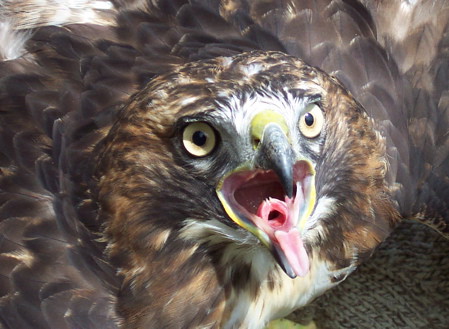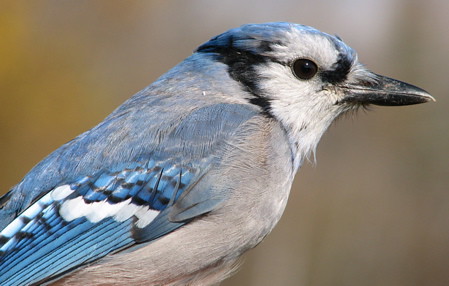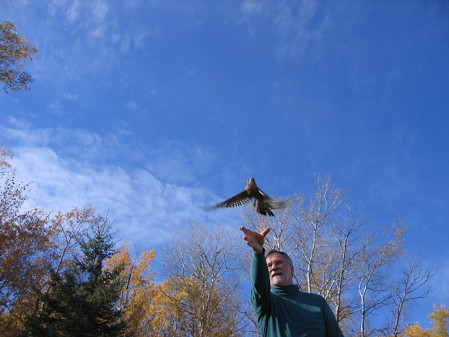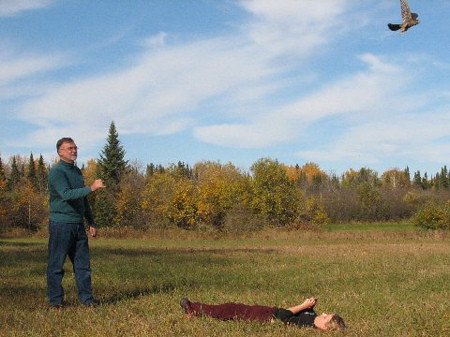I keep trying to write this blog entry, but my rabbit insists on using me as a jungle gym, making typing most difficult.
 Here's a photo of last weekend's banding crew (the only bummer is that Frank Taylor, the guy who runs the blind isn't in it). But from left to right we have Reier Grudem, Joan Schnabel, me, Amber Burnette (holding a red-tailed hawk), Rick Dupont, and Katy Dupont.
Here's a photo of last weekend's banding crew (the only bummer is that Frank Taylor, the guy who runs the blind isn't in it). But from left to right we have Reier Grudem, Joan Schnabel, me, Amber Burnette (holding a red-tailed hawk), Rick Dupont, and Katy Dupont.
 Frank Taylor just included this photo in his weekly banding report. That's me in the pigeon yanking seat holding the pigeon line and a sharp-shinned hawk I lured into the banding station by pulling the pigeon. Whoot!
Frank Taylor just included this photo in his weekly banding report. That's me in the pigeon yanking seat holding the pigeon line and a sharp-shinned hawk I lured into the banding station by pulling the pigeon. Whoot!
Above are two haggard (adult) sharp-shinned hawks. So, I gave you the info for how we have the banding station set up, now let's talk about some of the interesting things observed over last weekend. First off, birds were all over, both songbirds and raptors. Saturday morning, Amber, Reier and I arrived at the field and could see sharp-shinned hawks, harriers, merlins all moving and could hear blue jays all over. You would see flocks of blue jays miles away in your binoculars and there would always be at least one sharp-shinned hawk mixed in with the flock.
In the above photo is both a haggard (towards the back) and a passage (first year) sharp-shinned hawk. Note the difference in eye color and that the younger bird is brown and white and the older birds is dark blue with and orange breast. The passage sharp-shins were in hunting mode and were bound and determined to take out a blue jay. You would hear a flock of blue jays screaming and then all of a sudden you'd hear one give a strange honking call and that was usually a shin hot on its tail. We also saw flocks of smaller birds in the fields in front of the blind. At one point we had a white-crowned sparrow feeding in the grass in front of us. Just as we identified what type of sparrow it was, a passage sharp-shinned hawk flew down, landed on it, killed it and flew away with it's prize--in less than 40 seconds. It's was a much more effortless affair than the Cooper's hawk incident from yesterday.
Above is an up close shot of a haggard sharp-shinned. It was one of the busiest weekends I've ever experienced at this little hawk banding station. On Saturday we banded 32 birds (29 sharp-shins and 3 red-tails) and on Sunday we banded 34 birds on Sunday (33 sharp-shins, and 1 Merlin). We did have quite a few heart breaks, including birds bouncing out of the nets before we could get to them and one mouthy little female kestrel. When the kestrels come into the net, you are sure they are going to come in, but they always seem to find the net at the last second and dodge out of the way. This particular female, flew right to us with no intention of going for the pigeon and landed on one of the poles that holds the net. She looked directly to the blind and gave the loud kestrel cry--pretty much the equivalent of giving us the bird. It was as if she were screaming, "Hey, I know you guys are here and any predator withing the sound of my voice should stay away!!" We must have had her in the nets before.
Here's a haggard red-tailed hawk that came into the nets. This bird was a bit thin and its bill was a tad crusty looking. As Amber was banding it, she noticed that the left eye was clouded over. When you waved a finger in front of it, the hawk could see out of it at all.
Obviously the hawk had not been surviving well with this disability, but it had been surviving. Who knows exactly how long the birds had been living with sight in only one eye. The bird has been alive at least three years. When red-tailed hawks are young, they have yellow eyes (note the yellow eyes of a passage red-tailed hawk in the next photo). Their eyes get darker as they get older, this bird could very well be 15 years old. Glaucoma doesn't develop overnight, perhaps it has been such a gradual change the hawk has had a chance to adjust it's hunting style. Reier noted how it flew to take to view the bait pigeon and really, had the nets not been there, it would have been able to catch it. There really aren't any treatments for bird glaucoma so taking to the Raptor Center wasn't an option. After banding it, we let it go. Maybe it will survive another few years or maybe it's going to end its last days in a blaze of glory.
For a comparison, here's a very healthy passage red-tailed hawk, note the yellow eyes? This bird was having some tail issues:
Check it out, it's missing quite a few feather and has a mixture of both first year red-tail brown feathers and a red tail feather--what the heck is going on? Frank speculated that the tails feathers had been grabbed, maybe by another red-tail in a territorial fight, or by a nest mate, or even some other predator. The feathers are starting to grow back in, and the new feathers are growing in red because the body says "hey, after the second set, these should be red" but at the same time, the feathers are supposed to be brown striped, so you get some striping in there too. And since we have a photo of a red-tailed hawk with the wing extended, note how the wings look very long in relation to the body, and the tail is short in relation to the body--this is a characteristic of this type of hawk, known as a buteo. Compare that to a different hawk:
Here is a sharp-shinned hawk, they are accipiters and they have a shorter wing in relation to the body, and a very long tail--that's one way you can start to id hawks. When you see one, try to note if the tail is long or short compared to the body and if the wings look long or short. Incidentally, this is one of the birds that I lured into the nets.
The birds were coming into the nets so quickly, that at times we barely had time to get photos or to release banded birds. We were getting ready to release this merlin (in front) and this sharp-shin when Rick yelled that some birds were coming into the nets. We just ran behind the blind rather than taking the time to go in. Sometimes that's faster and if you're quiet, the birds will still come into the nets. I was going to take a photo of these two when all of a sudden both looked up. They were seeing hawks fly over too.
When we have a chance, I like to get photos of people releasing hawks. My favorite thing to do is lay on the ground and get a wing shot of the bird. When you release a sharp-shinned hawk, you can pretty much just open your hand and they take off towards the woods right away.
Reier got a photo of me releasing a red-tailed hawk. They are little heftier and you have to kind of fling them into the air so they don't just thunk on the ground. Unlike the sharp-shinned hawks that head straight for the safety of the woods as soon as they are released, red-tails stay in the open and try to find the nearest thermal to lift high into the sky.
At one point we had two sharp-shins to release and one merlin. We released them all on once (that's the merlin in the middle). Note the shin on the right aiming right for me? That was courtesy of Katy. I told her that she could just let it drop towards me, boy I think she kind of threw it at me. It's okay, I had it coming, I was making fun of her for texting her friends from the blind. And if you're worried, the bird didn't hit me and made it safely to the woods.
We got to do several multiple releases. Here's a video of a sharp-shinned hawk release. I'm holding a sharp-shin and aiming my camera at my hands. But since two people next to me are releasing birds, it looks like a magic trick: one bird turns into three:
And for those who can't see video, here's a couple of consolation photos:





































































